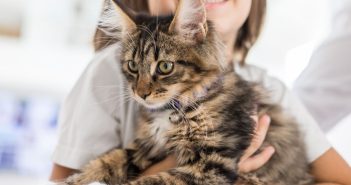Do you bathe your cat? 25% of people who subject their feline friend to water are kind enough to blow dry them afterwards. Did you know that 95% of cat owners admit that they talk to their cat? Mind you, this doesn’t always mean that the cat is listening; cats seem to have very selective hearing, at times, and frequently enjoy ignoring people. Don’t be fooled though; a cat’s hearing ranks up at the top of the animal kingdom and they can hear sounds as high-pitched as 65 kHz. A human can only hear as high as 20 kHz.
Want to tell your cat’s mood? Sure, cats make a contented purr noise when they are happy, but a far better judge of temper can be made by your cat’s tail. A cat who is happy will walk with his tail proudly bannered in a vertical position. Walking with the tail horizontal is common, but a tucked tail means insecurity or fear and a twitching tail means that your feline friend is irritated. Tails also help cats maintain their balance, jump, and are helpful to a cat when they take a fall and must maneuver to land on their feet.
Ever wonder why cats have such long whiskers? Originally, it was believed this was how a cat moved about in the darkness; that they felt their way in the dark, though this is not entirely true. A cat’s whiskers are useful feelers, but they are not limited to night-time activities. In fact, it is believed that a cat uses his whiskers more as a form of measurement. Having no true collarbone, a cat is able to fit through openings that his head can fit through. The 4 rows of long whiskers, extending from the cat’s face, as well as large whiskers over his eyes, are believed to help a cat determine whether or not they can fit in or out of any given area. After all, it simply wouldn’t do for a cat to get stuck!
According to legend, the “M” marking on the forehead of the tabby cat was created by the prophet, Mohammed, when he rested his hand lightly on the brow of his favorite cat, a tabby. Abraham Lincoln was also a cat lover; he had 4 of them when he lived in the White House, and Ernest Hemingway once had some 30 cats at his home, in Havana. Cardinal Richelieu was so fond of cats that he shared his home with 14 of them. Specially appointed attendants cared for his cats, and upon his death, the Cardinal left all his worldly wealth to his feline companions. Florence Nightingale owned more than 60 cats in her lifetime and Winston Churchill, adored cats. Churchill used to refer to his cat, “Jock”, as his special assistant. “Jock” was reported to be on the bed with his master on the day the great British statesman died. Who invented the swinging cat door? Sir Isaac Newton, the man who first described the principal of gravity created the swinging door for the convenience of his many feline friends.
Sadly, however, not everyone is a cat fancier. While a cat lover is an ailurophile, ailurophobe is the fear of cats. It is said that Julius Caesar, Henry II, Charles XI, and Napoleon all suffered from this and would nearly faint in the presence of a cat.
Cats have remained the most popular of all household pets throughout the ages. Intelligent, personable and beautiful, they have charmed their way into the hearts of many. Unfortunately, their popularity comes with a price; each day in the United States, animal shelters are forced to destroy 30,000 dogs and cats. All of this can be prevented by simply spaying or neutering a pet, and studies have shown that doing this may actually extend the life of many pets by 1-2 years.



